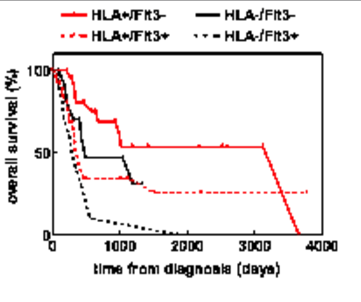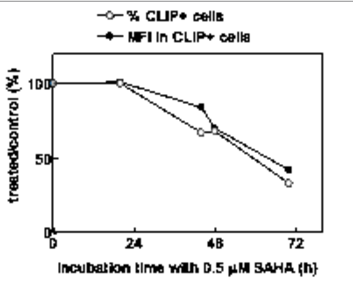Konference: 2015 57th ASH Annual Meeting - účast ČR
Kategorie: Maligní lymfomy a leukémie; Nádorová biologie/imunologie/genetika a buněčná terapie
Téma: 617. Acute Myeloid Leukemia: Biology, Cytogenetics and Molecular Markers in Diagnosis and Prognosis: Poster
Číslo abstraktu: 2572
Autoři: Kateřina Kuželová, Ph.D.; Mgr. Barbora Brodská, Ph.D.; Ing. Jana Marková; MD Grzegorz Helbig, Ph.D.; Prof. Dr. Slawomira Kyrcz-Krzemien, Ph.D.; prof. MUDr. Petr Cetkovský, Ph.D.
In our recent work, we described changes in HLA class I frequencies in AML patients with nucleophosmin (NPM) mutations. Several allelic groups were found to be depleted in patients with C-terminal NPM mutations (NPMc+), but not in patients with wild-type NPM, and these differences corresponded well to in silico prediction of NPM-derived peptides binding to HLA class I. Moreover, patients with "favorable" HLA type (i.e., expressing HLA alleles suitable for presentation of NPM-derived peptides) were found to have significantly better overall survival than those without suitable HLA alleles. Altogether, our results suggested that spontaneous anti-NPM immune response may prevent AML development and helps achieve durable cure.
In this contribution, an extended patient cohort (N = 71 patients with all available data) was divided into four groups according to HLA type (favorable/unfavorable) and Flt3-ITD status. Patients expressing suitable HLA alleles and not having internal tandem duplications in Flt3 gene (HLA+/Flt3-) had the best overall survival (Figure 1). The impact of unfavorable HLA type alone was comparable to that of Flt3-ITD positivity while the combination of both adverse factors was associated with particularly poor outcome (p = 0.0066 for trend).
On the basis of these results, we believe that NPMc+ AML patients with favorable HLA type (about 65% of all NPMc+ AML patients) could benefit from an immunomodulatory therapy. Besides inhibitory receptors (such as PD-1, CTLA-4, TIM-3), regulatory T-cells or decreased HLA expression, reduced antigen presentation by leukemic cells belongs to possible mechanisms of immune escape. Insufficiency of molecular complexes such as the proteasome or the transport-associated protein (TAP) can result in increased presentation of Class II-associated invariant chain peptide (CLIP). Indeed, increased CLIP expression on residual leukemic blasts has recently been reported to correlate with increased relapse risk in AML. Interestingly, valproic acid used in combination with standard chemotherapy has been described to significantly decrease the relapse rate in elderly AML patients with mutated NPM (but not in other AML subgroups). This could be associated with restored antigen presentation following treatment with histonedeacetylase inhibitors. In our experiments, we observed marked reduction of CLIP expression on primary NPMc+ AML blasts following in vitro treatment with suberoylanilide hydroxamic acid (SAHA, Figure 2). Both the fraction of CLIP-positive cells (open circles) and CLIP surface density on positive cells (closed circles) were reduced. HLA class I expression was normal and was not affected by SAHA treatment. Importantly, the effect on CLIP expression occurred even at subtoxic (0.5 µM) drug concentration.
|
Figure 1: |
Disclosures: No relevant conflicts of interest to declare
Datum přednesení příspěvku: 6. 12. 2015







